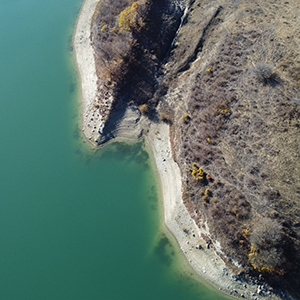Longitudinal recovery gradient of macroinvertebrates during different hydrological scenarios in a downstream river reach

Submitted: 12 January 2023
Accepted: 12 May 2023
Published: 7 June 2023
Accepted: 12 May 2023
Abstract Views: 1780
PDF: 324
Figure S1. MFA_Complex_Full_Partial_axes: 84
Figure S2. MFA_Complex_Full_IND: 75
Table S1. Taxonomic distribution: 68
Table S2. PCA_Bio_St: 71
Table S3. Environmental variables: 69
Table S4. Daily flow time series: 71
Table S5. PCA_Hydro_St: 77
Table S6. PCA_Chem_St: 72
Table S7. MFA_Complex: 80
HTML: 28
Figure S1. MFA_Complex_Full_Partial_axes: 84
Figure S2. MFA_Complex_Full_IND: 75
Table S1. Taxonomic distribution: 68
Table S2. PCA_Bio_St: 71
Table S3. Environmental variables: 69
Table S4. Daily flow time series: 71
Table S5. PCA_Hydro_St: 77
Table S6. PCA_Chem_St: 72
Table S7. MFA_Complex: 80
HTML: 28
Publisher's note
All claims expressed in this article are solely those of the authors and do not necessarily represent those of their affiliated organizations, or those of the publisher, the editors and the reviewers. Any product that may be evaluated in this article or claim that may be made by its manufacturer is not guaranteed or endorsed by the publisher.
All claims expressed in this article are solely those of the authors and do not necessarily represent those of their affiliated organizations, or those of the publisher, the editors and the reviewers. Any product that may be evaluated in this article or claim that may be made by its manufacturer is not guaranteed or endorsed by the publisher.
Similar Articles
- Amaia Pérez-Bilbao, Cesar J. Benetti, Josefina Garrido, Assessment of the effects of the dry period on the faunal composition of aquatic macroinvertebrate assemblages in two temporary ponds in NW Spain , Journal of Limnology: Vol. 74 No. 3 (2015)
- Angela Boggero, Lyudmila Kamburska, Silvia Zaupa, Marzia Ciampittiello, Michela Rogora, Tiziana Di Lorenzo, Synoptic results on the potential impacts of the Lake Maggiore water management strategy on freshwater littoral ecosystems and invertebrate biocoenosis (NW, Italy) , Journal of Limnology: Vol. 81 No. s2 (2022): Effects of water level management on lake littorals and downstream river areas
- Sonia Endrizzi, Maria Cristina Bruno, Bruno Maiolini, Distribution and biometry of native and alien crayfish in Trentino (Italian Alps) , Journal of Limnology: Vol. 72 No. 2 (2013)
- Monica Pinardi, Gary Free, Beatrice Lotto, Nicola Ghirardi, Marco Bartoli, Mariano Bresciani, Exploiting high frequency monitoring and satellite imagery for assessing chlorophyll-a dynamics in a shallow eutrophic lake , Journal of Limnology: Vol. 80 No. 3 (2021): Celebratory Issue - 80th Anniversary of the Journal of Limnology
- Ewa A. Dembowska, Paweł Napiórkowski, A case study of the planktonic communities in two hydrologically different oxbow lakes, Vistula River, Central Poland , Journal of Limnology: Vol. 74 No. 2 (2015)
- Piotr Dabkowski, Paweł Buczynski, Andrzej Zawal, Edyta Stepien, Edyta Buczynska, Robert Stryjecki, Stanislaw Czachorowski, Przemyslaw Smietana, Magdalena Szenejko, The impact of dredging of a small lowland river on water beetle fauna (Coleoptera) , Journal of Limnology: Vol. 75 No. 3 (2016)
- Maria V. López van Oosterom, Carolina Ocon, Laura C. Armendariz, Alberto Rodrigues Capitulo, Structural and functional responses of the oligochaete and aeolosomatid assemblage in lowland streams: a one-way-pollution-modelled ecosystem , Journal of Limnology: Vol. 74 No. 3 (2015)
- Margherita Abbà, Carlo Ruffino, Tiziano Bo, Davide Bonetto, Stefano Bovero, Alessandro Candiotto, Claudio Comoglio, Paolo Lo Conte, Daniel Nyqvist, Michele Spairani, Stefano Fenoglio, Distribution of fish species in the upper Po River Basin (NW Italy): a synthesis of 30 years of data , Journal of Limnology: Vol. 83 (2024)
- Angela Boggero, Elzbieta Dumnicka, Riccardo Fornaroli, Daniele Paganelli, Silvia Zaupa, Geotargeting spatial and temporal data of Italian freshwater high-altitude macroinvertebrates , Journal of Limnology: Vol. 82 No. s1 (2023): Georeferenced freshwater biodiversity data
- Andrew Liorti, Teresa Crease, Andreas Heyland, Interactive effects of copper and calcium in Daphnia pulex , Journal of Limnology: Vol. 76 No. 2 (2017)
<< < 5 6 7 8 9 10 11 12 13 14 > >>
You may also start an advanced similarity search for this article.

 https://doi.org/10.4081/jlimnol.2023.2125
https://doi.org/10.4081/jlimnol.2023.2125






